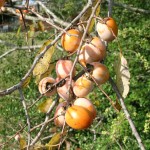Common Persimmon, Eastern Persimmon
Diospyros virginiana L.
Ebenaceae (Persimmon family)
Description
Common Persimmon is a shrub to small tree, standing 15 – 20 feet or 4.6 – 6.1 meters tall in older field sites. In optimum soils, the species can reach up to 80 ft or 24 m tall. Stems may be clumped because of seedling proximity or growth after the tree has been cut down. A native, cool-season perennial, it is also known as Eastern Persimmon. The bark is brown to black with deep fissures, and ridges are broken into rectangular, checkered sections. This plant has a characteristic leaf shape, bud scars, and new buds. The leaves are deciduous, simple, alternate, and entire. The inflorescence is bell-shaped and yellow to green in color which can be hidden by half-grown leaves. Bloom time can occur from March through June. Its fruit has four to eight seeds that are very hard and enable this plant to invade pastureland. As it matures, the fruit is at first green, turning yellow to orange and finally purple to black when fully ripened. Seeds are brown and flat, about 0.5 in or 13 mm in length. The optimum fruit-bearing age is 25 to 50 years old, but trees can bear fruit as early as 10 years. Fruits can fall from September to late winter. Persimmon is highly tolerant of shade. Common Persimmon provides fair forage for wildlife and poor forage for cattle. Fruits are consumed by many species of birds and mammals, with special value for honeybees.Habitat
Common Persimmon grows on most types of soils from sand to shale and in muddy bottomlands in the eastern and central parts of Texas. It grows best in moist, rich soils. Native habitat includes dry wooded areas, old fields, and clearings.Management Strategies
Because Common Persimmon can be considered a noxious plant in pastures and fields, efforts to manage it have been made with various herbicidal methods. Defoliation treatment is most effective in May when the leaves are fully expanded.Images
Plant Characteristics
Flower Color: Green, Yellow
Seed Type: Fruit/Berry
Duration: Perennial
Stem Texture: Hairless/Smooth
Growth Habit: Shrub (Woody)
Leaf Shape
 : Simple with Pinnate or Parallel Venation
: Simple with Pinnate or Parallel Venation
Season: Cool
Distribution
 : 01 - Pineywoods, 02 - Gulf Prairies and Marshes, 03 - Post Oak Savannah, 04 - Blackland Prairies, 05 - Cross Timbers and Prairies, 07 - Edwards Plateau
: 01 - Pineywoods, 02 - Gulf Prairies and Marshes, 03 - Post Oak Savannah, 04 - Blackland Prairies, 05 - Cross Timbers and Prairies, 07 - Edwards Plateau
Distributions
Distribution refers to the ecological region in Texas that a plant has been found. You can also view a clickable map.
Book: Brush and Weeds of Texas Rangelands (B-6208)
Collection: Brush and Weeds








